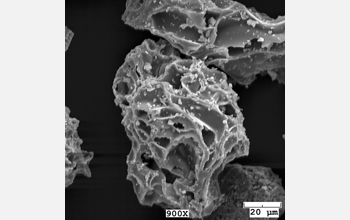Multimedia Gallery
SEM of volcanic ash from Redoubt Volcano, Alaska (Image 2)
A scanning electron microscope (SEM) image of an ash particle, collected following the volcanic eruptioin of Mount Redoubt in Alaska on March 22, 2009. The ash was collected during the ashfall in Healy, Alaska, by Pavel Izbekov, a research associate at the Alaska Volcano Observatory (AVO), Geophysical Institute of the University of Alaska Fairbanks (UAF), on March 23, 2009.
The image was created by Izbekov and Jill Shipman, a UAF graduate student studying with Izbekov, using an ISI-50 SEM at the Advanced Instrumentation Laboratory at UAF.
Volcanic ash--pulverized rock ejected from a volcano--consists of tiny jagged pieces of rock and glass. Unlike wood ash, newly ejected volcanic ash is sharp and abrasive. It can damage car finishes, clog machinery, vents, and pipes, and can cause respiratory discomfort. In large enough quantities, its weight can be enough to collapse roofs, especially if it gets wet.
The AVO is a joint program of the United States Geological Survey (USGS), the Geophysical Institute of the University of Alaska Fairbanks (UAFGI), and the State of Alaska Division of Geological and Geophysical Surveys (ADGGS).
This research was supported in part by grants from the National Science Foundation (OISE 05-30278 and EAR 06-36118). (Date of Image: March 2009) [See related image Here.]
Credit: Pavel Izbekov and Jill Shipman, University of Alaska Fairbanks
Images and other media in the National Science Foundation Multimedia Gallery are available for use in print and electronic material by NSF employees, members of the media, university staff, teachers and the general public. All media in the gallery are intended for personal, educational and nonprofit/non-commercial use only.
Images credited to the National Science Foundation, a federal agency, are in the public domain. The images were created by employees of the United States Government as part of their official duties or prepared by contractors as "works for hire" for NSF. You may freely use NSF-credited images and, at your discretion, credit NSF with a "Courtesy: National Science Foundation" notation.
Additional information about general usage can be found in Conditions.
Also Available:
Download the high-resolution JPG version of the image. (3 MB)
Use your mouse to right-click (Mac users may need to Ctrl-click) the link above and choose the option that will save the file or target to your computer.

